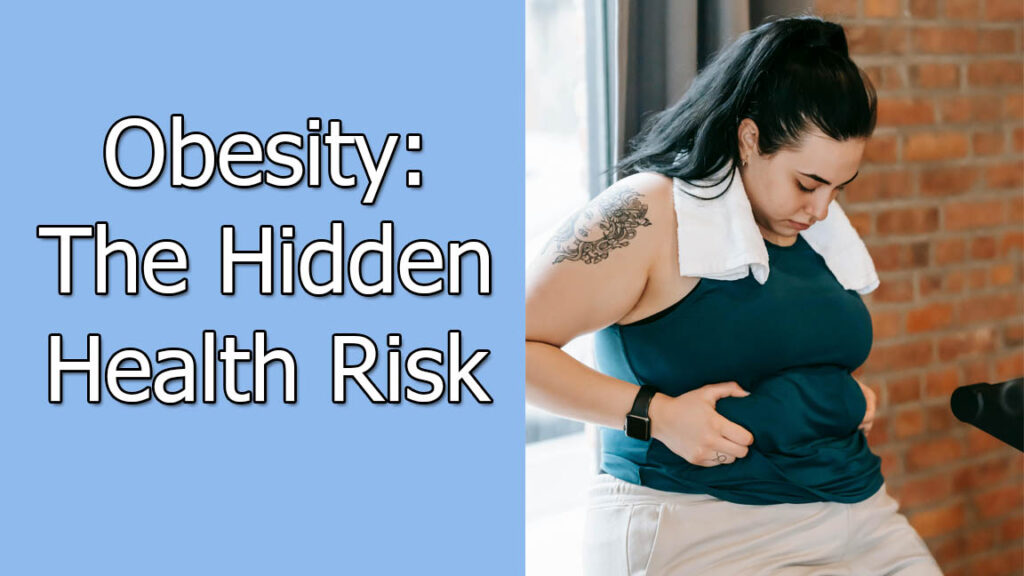Obesity isn’t just about numbers on a scale. It’s a daily, silent stress test on nearly every system of your body—your heart and blood vessels, your liver and pancreas, your brain and hormones, your sleep and mood. The damage happens quietly—through inflammation, hormonal misfires, and cellular wear-and-tear—until one day it isn’t quiet anymore.
Below is a deeply researched and practical guide to how obesity harms the body, drawing on evidence from the World Health Organization (WHO), The Lancet, Harvard T.H. Chan School of Public Health, IARC/WHO (the cancer arm), the American Academy of Sleep Medicine, and major peer-reviewed journals including BMJ, Gastroenterology, and more. Where claims may have changed since older guidelines, I’ve used the most recent trustworthy updates and noted the dates.
why obesity quietly hurts cells and organs every day
Chronic low-grade inflammation: Excess fat tissue—especially around the abdomen—acts like an endocrine organ, releasing inflammatory molecules (adipokines and cytokines). That “background inflammation” accelerates atherosclerosis, worsens insulin resistance, disrupts hormones, and stresses mitochondria (your cells’ powerhouses). Classic cardiometabolic literature has mapped these adipokine-related pathways to heart disease risk.
Insulin resistance and mitochondrial stress: Fresh evidence from Harvard T.H. Chan School of Public Health (May 28, 2025) describes a newly clarified mechanism whereby obesity impairs mitochondrial function in muscle and liver, driving insulin resistance—a key step toward type 2 diabetes.
Diet quality and ultra-processed foods (UPFs): Large cohort syntheses in BMJ (2024) link higher UPF intake with higher risk of cardiometabolic disease, depression, and mortality. UPFs are energy-dense, low in fiber/micronutrients, easy to overconsume, and engineered for speed, shelf life, and hyper-palatability—amplifying weight gain and metabolic strain.
Liver overload and new terminology: The condition long known as NAFLD has been renamed metabolic dysfunction–associated steatotic liver disease (MASLD/MASH) to reflect metabolic drivers beyond alcohol—conditions that frequently travel with obesity. This re-naming, adopted by liver societies and journals in 2023–2024, helps clinicians address the true root: metabolic dysfunction.
Sleep and weight gain: a two-way street: Obesity worsens obstructive sleep apnea (OSA), which in turn disrupts sleep and appetite hormones, encouraging further weight gain. The American Academy of Sleep Medicine has emphasized this bidirectional loop for years
The global picture you can’t ignore
Let’s set the stage. Globally, obesity has risen across every age group. From 1990 to 2022, the share of adults living with obesity more than doubled, and the share of children and adolescents (5–19 years) with obesity quadrupled from 2% to 8%. In 2024, an estimated 35 million children under 5 were overweight—nearly half of them in Asia. These aren’t just statistics; they’re a preview of tomorrow’s disease burden. World Health Organization
A comprehensive Lancet analysis published in 2024 underscores the trend: across 1990–2022, underweight fell in many places while obesity rose sharply, reshaping the health landscape for both women and men.
Your heart and blood vessels: pressure, plaques, and daily wear ❤️
Every day, the heart pumps against extra resistance when the body is carrying more mass and more inflammation. Adipokines and insulin resistance shift endothelial function (the inner lining of blood vessels), stiffen arteries, and accelerate plaque formation—setting the stage for hypertension, coronary artery disease, atrial fibrillation, and stroke. Mechanistic and clinical literature repeatedly connects obesity to atherosclerosis via inflammatory and hormonal pathways.
UPFs add fuel to the fire: diets rich in ultra-processed foods correlate with higher risk of cardiometabolic disease in pooled analyses. Pair that with sedentary time and short sleep, and the daily cardiovascular “load” rises further.
Takeaway: Even in the absence of a formal diagnosis, obesity nudges blood pressure, lipids, and vessel inflammation upward—quietly, cumulatively, and meaningfully.
The pancreas and blood sugar: the slow slide toward diabetes 🍬
Insulin is your blood sugar “key.” With ongoing weight gain, cells respond less to insulin—forcing the pancreas to produce more. Over time, those insulin-producing beta cells tire out. The newer Harvard work on mitochondrial dysfunction in obesity adds a cellular mechanism for how insulin resistance hardens into type 2 diabetes. It’s not just calories; it’s cellular energy failure and inflammation. Harvard Chan School of Public Health
Daily markers include rising fasting glucose, elevated triglycerides, and creeping waist circumference—the trio signals metabolic strain that often precedes diabetes by years.
The liver: fat build-up, inflammation, scarring (MASLD/MASH)
The liver filters your blood and processes nutrients. With obesity, fat accumulates in hepatocytes (liver cells), leading to MASLD. In some people it progresses to MASH (inflammation and injury), then fibrosis, cirrhosis, and even liver cancer. The global re-framing of NAFLD to MASLD/MASH (2023–2024 consensus) is more than a label—it recognizes obesity-driven metabolic dysfunction as the core cause. Weight loss (even 7–10%) can reduce liver fat and improve inflammation, but the longer the exposure, the harder the reversal.
The brain: memory, mood, and cognition 🧠
Midlife obesity raises the risk of later cognitive impairment and dementia. A 2020 systematic review and meta-analysis of prospective studies found that midlife obesity was associated with ~31% higher risk of cognitive impairment/dementia, with risk scaling up as BMI crossed ~30–32 kg/m² in dose-response analyses. Mechanisms likely include vascular damage, insulin resistance in the brain, and chronic inflammation.
Mood matters, too. High UPF intake has been tied to higher risk of common mental disorders in pooled data. Metabolic health and mental health are intertwined—sleep, inflammation, insulin, and gut-brain signaling all play roles.
Cancer: more sites than most people realize 🎗️
Obesity increases the risk of multiple cancers. The International Agency for Research on Cancer (IARC/WHO) has linked body fatness to a higher risk of cancers of the breast (postmenopausal), colon, liver, pancreas, kidney, endometrium, ovary, and others—supported by both animal and human data. The mechanistic picture includes insulin and IGF-1 signaling, inflammation, sex hormones, and adipokines.
The daily reality: repeated exposure to inflammatory and hormonal imbalances slowly raises risk. This is why sustained lifestyle change—even modest weight loss—can yield disproportionate cancer-prevention benefits over time.
Lungs and sleep: when breathing itself is under pressure 😴
Extra soft tissue around the neck, tongue, and airway narrows the breathing passage during sleep. Obstructive sleep apnea causes repeated pauses in breathing, lowering oxygen and stressing the cardiovascular system. The relationship is two-way: obesity raises OSA risk, and untreated OSA worsens weight gain and metabolic health by wrecking sleep quality and altering appetite hormones (ghrelin/leptin). Clinicians emphasize screening for OSA in patients with obesity, loud snoring, or resistant hypertension.
Joints, muscles, and mobility: more load, less repair 🦴
Knees, hips, spine, and even smaller joints experience higher compressive forces every day. Inflammation from fat tissue also degrades cartilage. Over time, osteoarthritis risk climbs, and movement becomes painful—creating a vicious cycle where less activity drives further weight gain.
Hormones and fertility: quiet disruptions with big consequences
Adipose tissue converts and stores hormones. With more fat mass, sex hormone balance shifts, menstrual cycles can become irregular, and PCOS risk increases—impacting ovulation and fertility. In men, lower testosterone and poorer sperm parameters are reported with higher adiposity. These effects accumulate silently long before someone seeks fertility care.
The gut and the food environment: not “just willpower”
The modern food environment—dominated by cheap, accessible, ultra-processed foods—nudges daily choices toward calorie-dense, nutrient-poor patterns. Pooled analyses show higher UPF intake tracks with higher risk of obesity and multiple adverse outcomes. This isn’t a moral failing; it’s biology meeting environment. The path back involves designing defaults you can live with: more whole foods, fiber, protein anchors, and slow eating.
Children and teens: why early weight matters for adult health 👧🏽🧑🏻
Excess weight in childhood tracks strongly into adulthood, raising lifetime risk of diabetes, heart disease, sleep apnea, and some cancers. U.S. surveillance shows ~19.7% of youths aged 2–19 have obesity (2024 CDC update). Globally, WHO notes tens of millions of children under 5 with overweight, with the fastest growth in regions that once faced undernutrition. Prevention in families and schools—sleep routines, active play, fewer UPFs—pays off for decades. CDCWorld Health Organization
Five “hidden” daily harms you may be feeling already (but didn’t connect)
- Morning fatigue despite “enough” sleep → screen for OSA and sleep quality; small weight loss helps.
- Constant heartburn → abdominal fat increases reflux pressure; weight loss and meal timing help.
- Brain fog after meals → swings in glucose/insulin plus poor sleep; steadier meals (protein/fiber) reduce “post-lunch crash.”
- Aching knees with stairs → inflammatory load plus mechanical stress; low-impact training helps rebuild tolerance.
- Irregular periods or fertility delays → adiposity-driven hormonal shifts; 5–10% weight loss can restore ovulation in many.

What actually works: research-backed levers you can pull today
1) Aim first for 5–10% weight loss, not perfection: Even 5–10% can lower liver fat, improve insulin resistance, reduce blood pressure, and calm inflammation—benefits that start well before larger losses. (MASLD/MASH literature and cardiometabolic trials support this stepwise benefit model.)
2) Make UPFs less convenient; make whole foods automatic: Given the BMJ-summarized risks, treat UPFs like a “sometimes” category. Build meals around protein (satiety), fiber (glycemic smoothing), and water-rich plants.
3) Move daily, but protect joints: Prefer low-impact zones—walking, cycling, swimming, rowing. Strength work builds insulin sensitivity and increases your “metabolic allowance” without beating up knees.
4) Sleep 7–9 hours; screen for OSA if snoring/daytime sleepiness: Treating sleep apnea reduces blood pressure and makes weight loss easier to sustain.
5) Design your environment: Smaller plates, visible fruit/veggies, pre-portioned nuts/yogurt, and an “out of sight” rule for snack foods quietly cut hundreds of calories a day—without constant willpower.
6) Track what matters: Waist circumference, morning weight trends, steps, and resistance sessions tell you whether your plan is working a week at a time—no obsession, just signal.
7) Medical therapy and clinical care: For some, evidence-based anti-obesity medications and bariatric procedures are appropriate. Pairing clinical tools with behavior change yields the most durable metabolic improvements, especially when MASLD/MASH, diabetes, or severe OSA are present. (Talk with your clinician, as indications and safety evolve regionally.)
The day-by-day reversal: how the body heals when weight trends down 🌱
- Heart & vessels: Blood pressure eases; endothelial function improves; lipid profiles shift in a cardioprotective direction.
- Pancreas: Insulin sensitivity rises; post-meal glucose spikes flatten; beta-cell stress lightens.
- Liver: Fat content drops; inflammation quiets; fibrosis progression can slow—especially with early action.
- Brain: Sleep improves; mood steadies; midlife risk curves for later impairment tilt in your favor.
- Cancer risk: Hormonal and inflammatory drivers reduce; long-term risk begins to fall.
- Sleep: OSA severity falls with even modest losses; energy and appetite regulation rebound.
Frequently Asked Questions (Evidence-Based) ❓
Q1) Is obesity always a personal choice?
No. Biology, environment, medications, sleep, stress, and socioeconomic context all shape weight. That’s why population-level shifts (e.g., UPFs, sleep loss, sedentary work) parallel rising obesity in WHO and Lancet data. Personal action matters, but the environment matters too. World Health Organization
Q2) I’m “metabolically healthy but obese.” Am I safe?
You may have normal labs today, but risk accumulates with time. Chronic inflammation and organ strain often precede abnormal tests. Regular monitoring and gradual weight loss still deliver protection.
Q3) Do ultra-processed foods really make that big a difference?
Large syntheses show higher UPF intake associates with higher cardiometabolic and mental health risks. Shifting to minimally processed foods improves satiety and nutrient density—without micromanaging calories.
Q4) How much weight loss helps fatty liver disease (MASLD/MASH)?
Even 7–10% loss reduces liver fat and inflammation; more may be needed for fibrosis regression. Early, sustained action works best.
Q5) Does obesity increase cancer risk? Which cancers?
Yes. IARC/WHO links obesity to several cancers including postmenopausal breast, colon, liver, pancreas, kidney, endometrium, and ovary, among others. Mechanisms involve insulin/IGF-1, sex hormones, and inflammation.
Q6) What about kids—can early weight really affect adult risk?
Yes. Excess childhood weight tracks into adulthood and elevates lifetime risk. U.S. and global data confirm high prevalence and rising trends. Early habits around sleep, movement, and food quality matter.

Simple Daily Health Template for Better Weight & Energy 🗓️
1. Breakfast — Start Your Day With Protein + Fiber
Goal: Keep you full longer, balance blood sugar, and avoid morning energy crashes.
- Protein source:
- Eggs (boiled, scrambled, or omelette)
- Greek yogurt (unsweetened)
- Paneer cubes
- Fiber + slow carbs:
- Fresh fruit (apple, berries, papaya, banana in moderation)
- Oats (steel-cut or rolled)
- Whole-grain toast or multigrain roti
Why: High-protein breakfasts can reduce hunger hormones and improve metabolism.
2. Lunch — Color + Lean Protein
Goal: Provide steady energy, support muscle, and add antioxidants for long-term health.
- Protein options:
- Dal or lentil soup
- Chickpeas, kidney beans, or sprouted moong
- Grilled chicken or baked fish
- Veggie load (color = nutrients):
- Big salad with tomatoes, cucumber, carrots, leafy greens
- Lightly sautéed or steamed veggies (broccoli, beans, capsicum, spinach)
- Whole grain carbs:
- Brown rice, quinoa, or whole wheat roti
Why: Balanced lunch prevents afternoon sugar cravings and keeps your metabolism active.
- Brown rice, quinoa, or whole wheat roti
3. Snack — Planned, Not Grazed
Goal: Avoid random eating that leads to overeating.
- Healthy snack ideas:
- A handful of nuts (almonds, walnuts, pistachios)
- Fresh fruit + yogurt
- Paneer cubes with a pinch of black salt and pepper
Why: Keeps blood sugar stable between meals and stops the “evening binge” habit.
4. Dinner — Lighter & Earlier
Goal: Aid digestion, improve sleep, and prevent late-night fat storage.
- Protein:
- Legumes like masoor dal or moong dal
- Fish (grilled, baked, or steamed)
- Lean chicken breast
- Vegetables:
- 2 different kinds (1 leafy + 1 starchy or non-starchy)
- Small whole-grain portion:
- 1 small roti or ½ cup brown rice
- Timing:
- Finish 2–3 hours before bed
Why: Eating earlier gives your body time to digest and lowers the risk of acid reflux or poor sleep.
- Finish 2–3 hours before bed
5. Movement — Keep the Body Active
Goal: Burn calories, improve heart health, and maintain muscle.
- Daily target:
- 30–45 minutes low-impact activity (brisk walking, cycling, swimming)
- Strength training:
- 2–3 short sessions weekly (bodyweight squats, push-ups, resistance bands)
Why: Strength training helps preserve muscle while losing fat — crucial for long-term metabolism.
- 2–3 short sessions weekly (bodyweight squats, push-ups, resistance bands)
6. Sleep — The Silent Fat-Burner
Goal: Improve recovery, balance hunger hormones, and reduce stress eating.
If you snore or wake up tired, get screened for Sleep Apnea (OSA)
Why: Poor sleep raises cortisol (stress hormone) and can cause weight gain, especially belly fat.
Daily target: 7–9 hours of quality sleep
Tips for better sleep:
Keep bedtime and wake time consistent
Avoid heavy meals or screens right before bed
Final Thought 💬
Obesity doesn’t destroy health overnight — it chips away at it, day after day, in ways you may not even notice until the damage is done.
The same slow, hidden process that harms your body can also heal it — but only if you act.
Even small, consistent changes in food choices, movement, sleep, and stress can reverse years of silent damage.
Your body is already working for you 24/7 — start working with it, not against it.
Start today. Your future self will thank you.
🚨 Your Kitchen is Hiding a Silent Killer! 😱
🍭 Sugar — every bite is slowly poisoning your body.
🍞 Maida — eating you from the inside without you even knowing.
💡 Truth You Must Read Now:
🔗 Sugar: The Daily Poison Hiding in Your Food
🔗 Maida: Eating You From the Inside — Health Risks
📌 Follow E-Vichar for More Life-Saving Insights:
👉 facebook.com/people/E-Vichar/61577438743345/
⚠️ Don’t just scroll — share this now. You might save someone’s life ❤️




